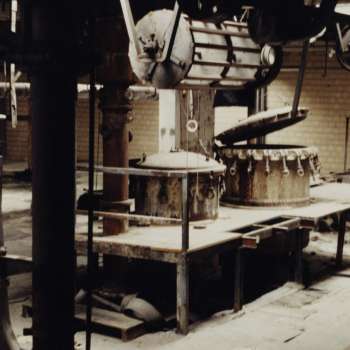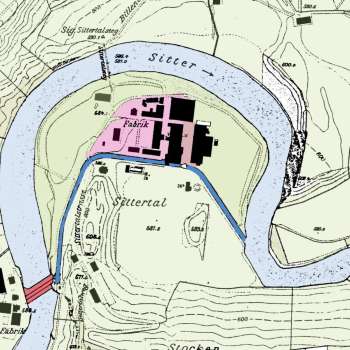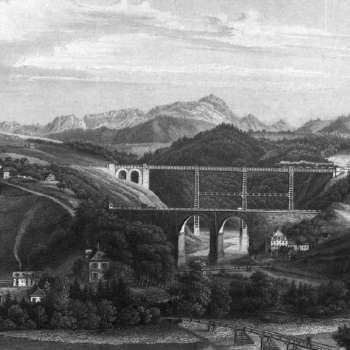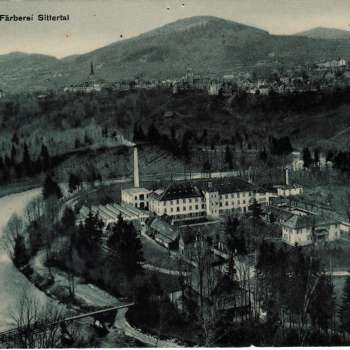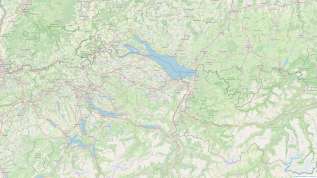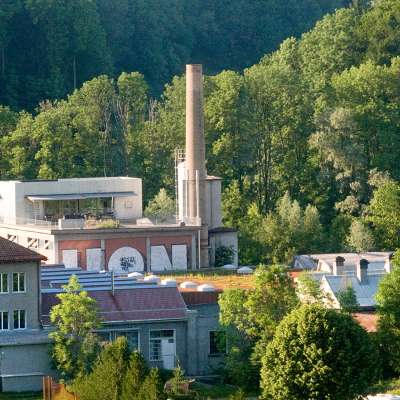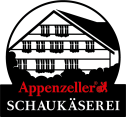Färberei Sittertal (Sittertal dyeing works)
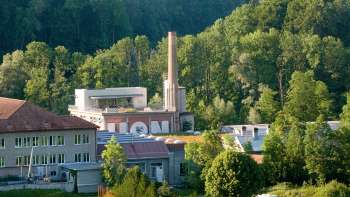
The finishing industry was an important piece of the textile production chain and rapid changes made it technically and commercially challenging.
History:
The first enterprise in the Sittertal was a failure: Friedrich Züblin's flax spinning mill, built in 1840, had focused on the past instead of the future of cotton by turning to canvas production. In 1866, Otto Rittmeyer set up a machine embroidery shop in the buildings, which was in operation until 1890. The factories then stood empty until 1904, when Johann Haeni-Merhart, owner of Waldegg Castle and the textile operations at Burgweiher near Schönenwegen, took over the facilities in the Sittertal. He had a new bleaching plant built with a transmission porch, boiler house and high chimney (architect: Josef Kinast). This gave rise to the Sitterthal dye works.
Architecture:
The factory and building complexes of the former Sitterthal dye works are characterized by one structural element: the canal. In the first construction phase in 1840, this harnessed the water power of the River Sitter. The first factory building was erected at right angles to the canal, which meant that the entire length of the hall could be served directly by a transmission system. All subsequent buildings and conversions were based on this grid - even when the water power had long since ceased to be used.
In the following decades, other parts of the building were continuously added or converted in the rapid rhythm of technological progress. In the process, the existing structures were integrated so that only industrial archaeological remains of the original 1904 plant can still be found. The high-tech textile finishing factory reached its full expansion around 1970, but experienced an economic decline in the years that followed.
Current use:
After the definitive closure of the factory in 1990, the resulting industrial wasteland slowly filled with life again. Gradually, new businesses moved in and new living space was created at the same time. Today, over 20 companies with more than 400 jobs are located in the Sittertal. Worth mentioning in particular are a large-scale operation of the Dock Group, a social enterprise for the work integration of the long-term unemployed, the Spörndli & Seger AG machine factory and the Kunstgiesserei AG art foundry with other associated cultural businesses. Since 2006, the non-profit Sitterwerk Foundation has also been at home in the Sittertal, which forms an institutional center for culture with its art library, the materials archive, the studio house and the Josephson boiler house.
Address
Färberei Sittertal
Sittertalstrasse 34
9014
St. Gallen
Switzerland
Responsible for this content: St.Gallen-Bodensee Tourismus
Report error (ID: 122897a8-9b02-48f1-bd98-5c58bb804026)
Report error (ID: 122897a8-9b02-48f1-bd98-5c58bb804026)


